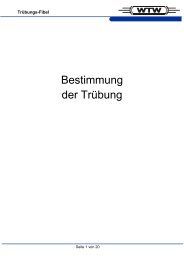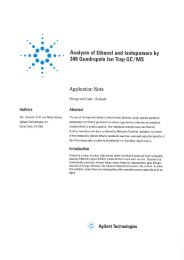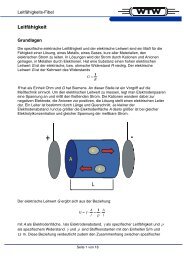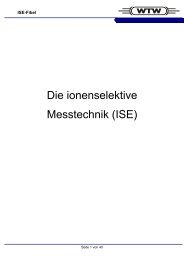Download PDF approx. 0,6 MB - Omnilab
Download PDF approx. 0,6 MB - Omnilab
Download PDF approx. 0,6 MB - Omnilab
Create successful ePaper yourself
Turn your PDF publications into a flip-book with our unique Google optimized e-Paper software.
SpanStabilisation timeStandard deviationThe correlation of the displayed weight value with the conventional mass value of the test weight on the balance is checked.The test weight should be traceable to a national standard, and is subject to monitoring.The time that elapses between completely placing the sample on the balance and obtaining the final result of the measurement.The stabilisation time can be influenced by selecting a different digital filter algorithm in the balance operating menu.A mathematic quantity for assessment of a balance with respect to its repeatability.The standard deviations ‘s’ is defined aswhere:n = number of individual resultsx = arithmetic mean of the individual results x iTaringTemperature coefficientTraceabilityUncertainty of measurementVerificationVerification scale interval (e)Weighing instrument verifiablefor legal metrologyExample of a normal distribution:Within ± 1 s ± 1.5 s ± 2 s ± 3 sSets the display to zero when a load is on the balance. This allows the display to be zeroed when an empty container is on theweighing pan, and the net weight to be read off after the container has been filled.Relative alteration of a value (e.g., zero point or sensitivity) when the temperature changes; the value is divided by the amountof temperature change.It can be stated in ppm/K or 10 -6 /K;e.g., a temperature change of 1 Kelvin (1°C) and a temperature coefficient of 1 · 10 -6 /K yields:Δm = 1 · 10-6 K-1 · 1 K · 100 g = 0.0001 gCharacteristic of a measurement result that can be traced back to a national or international reference weight through an unbrokenchain comparative weighing operations.This indicates the range above and below the result of measurement within which the unknown, error-free result lies with astatistical certainty of generally 95%.Example of a weighing result indicated with the uncertainty of measurement:m = (139.27457 ± 0.00002) g.Sartorius technicians can determine the uncertainty of measurement at the place of use of the balance and record it an officialcalibration certificate (accredited by the German Calibration Service, or DKD, in Germany for instance).Designation of the relative uncertainty of measurement (relative to the initial weight) is an important parameter for evaluation inthe laboratory environment.The legally mandated evaluation of a measuring instrument to determine its conformity with legal requirements, based on botha technical examination and the labeling of the instrument.A value expressed in a legal unit of measurement (mg, g, kg, t, ct) used during the evaluation of the weighing instrument andreferenced in defining the maximum permissible error on verification.A balance that has been approved for verification.Robert-Hooke-Str. 8 · D-28359 Bremen / Germany · Phone +49 (0)421 / 1 75 99-0www.omnilab.de · international@omnilab.deFlexible. Reliable. Personal.
















